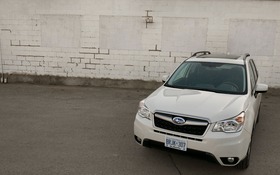2016 Subaru Forester: Boxing Its Way To Success

| Strong points |
|
|---|---|
| Weak points |
|
There's something to be said for daily transportation that never asks you to give it a second thought. The 2016 Subaru Forester takes on the most thankless of roles in the automotive industry - that of affordable family hauler - and it puts in a performance worthy of a best supporting actor statue. Think of the Forester as the character player that glues each scene together but never draws attention away from the star turn put in by you, your kids, your dogs, and the incredible amount of mud that the latter two somehow manage to track all over everything.
Steve Buscemi might not ever win any self-congratulatory hardware, but he keeps getting work year after year. The Subaru Forester's similar lack of glitz reveals an honesty about its sense of purpose and practicality, putting it into the compact SUV conversation alongside quicker, flashier, more technologically advanced models despite its name not being above the title.
Big, Useful Box
Although it qualifies for the compact segment, the 2016 Subaru Forester is fairly generously proportioned. Fortunately for your parking prospects, most of its girth is vertically distributed, with an especially tall roofline and 8.7 inches of ground clearance giving it a somewhat imposing profile. On the road, however, much of the Forester's size disappears - at least, from behind the steering wheel - leaving you to enjoy the spoils of its large cabin without feeling like you're piloting a much larger vehicle. Passenger room is excellent front and rear, but where the Subaru truly shines is in the cargo department, where it stands amongst class leaders like the Toyota RAV4 and the Honda CR-V with the second row of accommodations folded forward.
One other thing to keep in mind about the Forester is that, like its relatively anonymous exterior styling, its passenger compartment doesn't offer much in the way of visual excitement. The modestly-spec'd trim level I drove restricted its comforts to heated seats wrapped in easy-to-clean cloth, along with a large sunroof and a touchscreen infotainment system. You can spend more for leather and a louder stereo system, but if you're looking for luxury from Subaru you'll quickly find its an order sheet of diminishing returns: it's better to focus on the vehicle's utility rather than its potential to be pimped out.
Still Reaching For That Technological Rainbow
About that infotainment system I mentioned above: Subaru has a long history of underwhelming or outright frustrating its customers in terms of its communications and entertainment head units and Bluetooth connectivity options. The Subaru Forester offers a fairly straightforward process for hitching up your mobile device, but navigating around its various sub-menus - especially when it comes to dealing with satellite radio presets, for example - can be a trying experience.
That being said, the automaker does offer a compelling suite of available high tech safety features with the Forester that present no such challenges to logic and reason. The SUV can be ordered with the brand's EyeSight stereoscopic camera system that keeps a close watch on the road ahead in order to provide forward collision warning, lane departure warning, and even automated braking.
Remember The Mission
The 2016 Subaru Forester is available with the choice of two four-cylinder engines: a 2.5-litre mill that produces 170 horsepower and 174 lb-ft of torque, and a 2.0-litre turbocharged motor (in the XT trim) that ups the ante to 250 ponies.
The vehicle I drove for a week was equipped with the entry-level unit under its hood, although it swapped the Forester's standard (and rare for its class) six-speed manual transmission for the option of a continuously-variable automatic gearbox. Designed with frugality at the fuel pump in mind, Subaru has given this engine combo enough grunt to keep up with the flow of traffic, but don't expect much driver engagement to be had outside the turbo model. Acceleration isn't improved by flipping through the paddle shifters grafted behind the steering wheel, and handling is tepid and informed by the Forester's high centre of gravity (which also makes it more vulnerable to being pushed around by blustery winds). Still, the SUV's ride is comfortable and controlled, thanks in part to its standard all-wheel drive system.
Trucklet
Few compact SUVs feel the need to make any pretensions towards off-road capability now that we've all come to terms with the fact that our daily commutes don't involve mud bogs and boulders. With its upright styling, seemingly endless storage capacity, and X-Mode low-range simulator for its all-wheel drive system, the 2016 Subaru Forester brings you closer to the sport-utility spirit of old without forcing you to endure the crash-bang chassis setups that dominated that early era (or the polarizing needle-nose looks of the similarly rugged Jeep Cherokee Trailhawk). Given that the Forester is one of the most popular models in Subaru's line-up, it would seem that this mission profile resonates with more than a few budget-conscious families.











